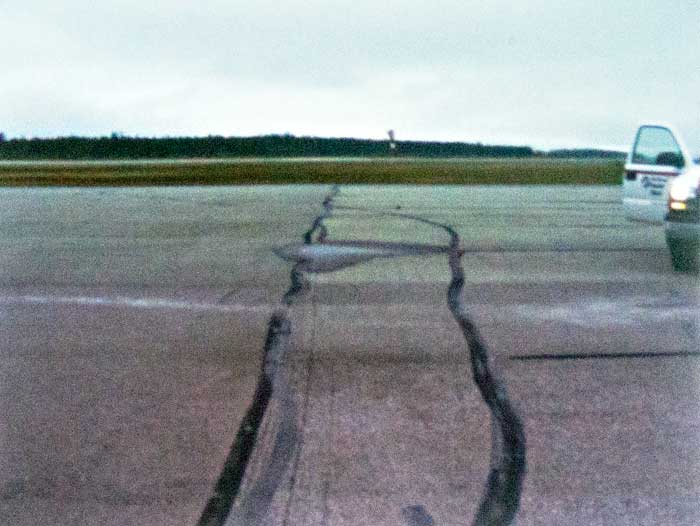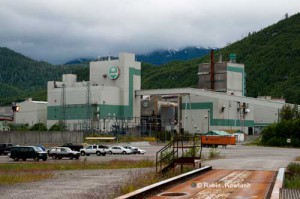
The boom in construction in the Kitimat area, together with future energy projects, means Northwest Regional Kitimat Terrace Airport is straining beyond capacity, District of Kitimat Council was told at the regular meeting Monday, March 5, 2012.
The airport is looking for $966,000 for works alone to expand the current aprons at the terminal building. The airport is also looking for money to improve the runways, which date from the Second World War.
The airport says that in 2010, traffic to the Kitimat Terrace airport accounted for 48 per cent of all passenger traffic in northwestern BC and 47 per cent of all total aircraft flying in the northwest.
From January 1, 2011 to September 30, 2011, air traffic at the Kitimat Terrace airport increased by 20 per cent. Total passenger traffic in 2011 increased by 14 per cent.
After hearing a presentation from airport manager Carmen Hendry, Kitimat council voted to put $34,000 of its Northern Development Initiative Trust Funding toward the project.
Service to the Kitimat Terrace airport by the airlines was cut back a number of years ago due to declining passenger load, with Air Canada dropping 737 service in favour of the current turboprop aircraft.
Now with increased traffic, the apron at the terminal is beyond capacity, just with the current Air Canada Jazz and Hawkair traffic. The current airport configuration allows for two aircraft parking stands within the restricted area. That means aircraft from the third commercial line to use the airport, Central Mountain Air must park in an area considered not secure and that requires extra security personnel on at the terminal apron. This area is also used for courier and ambulance/medevac aircraft.
Traffic from corporate jets is also increasing beyond the current capacity, with overnight parking slots for two medium sized and one small aircraft. Hendry says with the number of both Gulfstream and Learjets now using the airport the apron is often full.
Hendry says that the airport has had discussions with KBR, the prime contractor for the KM LNG project and he says the company has told him that during the construction of the LNG terminal, KBR expects that as many as 600 passengers could be flying in and out of the airport each week, meaning 70,000 additional passengers will be flying in and out of the airport a year during the construction.
That also means that the airlines could upgrade the aircraft serving the Kitimat Terrace airport to a Boeing 737-800 or an Airbus 320. The means the apron must be enlarged to accommodate the aircraft so there are no “wingtip to wingtip conflicts.”
The project would add a third aircraft stand within the restricted commercial operations zone and one aircraft stand outside the restricted area that could accommodate large cargo and corporate traffic. The overnight parking area would also be increased. The airport would then have a capacity for two large Gulfstream 500 series large corporate jets and a number of smaller Learjets
Hendry said that the airport has not heard officially from Air Canada has any plans to increase the capacity of its aircraft flying into the airport to the 737 series. There is also a possibility that Westjet might add service to the Kitimat Terrace airport. Mayor Joanne Monaghan said she had had discussions with Air Canada and was told that Air Canada might send a team to evaluate the situation sometime in late summer. “No one is ready to commit,” Monaghan said and Hendry nodded in agreement.
Legacy of World War II
The last time there were major improvements to the airport runways was in 1990. The current plans call for replacement of asphalt and the creation of a safe area for snowplows so that clearing the runways during the heavy snows can be faster.
The biggest problem facing airport runways is a legacy of the Second World War, when the airport was built in 1943. Worried about a possible Japanese invasion, the runways were built with “demolition ducts” every 100 to 150 metres. The ducts were constructed using two by ten wood braces, and filled with explosives that could be detonated in case of a Japanese landing.

The explosives were removed at the end of the Second World War, but the ducts remained.
“The wood is decaying and dropping down, creating bad divots on the runways,” Hendry said. The plans now call for ripping out the now 70-year-old rotten wood. The “divots” would be filled and compacted and then repaved. The runway improvement phase would cost $149,500.
Asked by council members if there would be any airport improvement fees, Hendry said the complete cost of the upgrades will be covered by NDIT and other grants.
The strain on the Kitimat Terrace airport brought controversy last fall, when the airport, together with Kitimat and Terrace Councils asked Public Safety Minister Vic Toews to station the Canadian Border Services Agency at the airport and allow the airport to use the CANPASS system for corporate aircraft. Without CBSA and CANPASS at Terrace Kitimat airport, executives from energy and other companies have to land at another airport to clear customs and immigration before going onto YXT, increasing fuel and other costs for those companies and also increasing flying time.
Toews, in a letter to Kitimat in December 2011, said that the CANPASS office at Prince Rupert is 52 kilometres too far away from the airport to service the pass system. As well, Toews said “actual demand” at the airport does not support the need for CBSA, without citing the date of any figures that would support that position.
Read Vic Toews letter to Kitimat Council (pdf)
Plans for the new airport apron at Kitimat Terrace airport.











